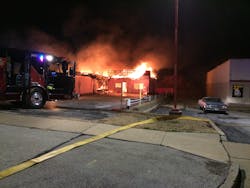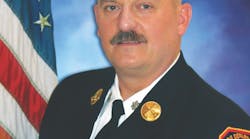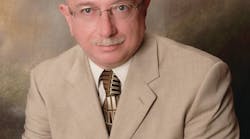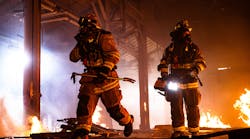Last year, the relatively unknown city of Ferguson, MO, was catapulted into the international media spotlight following the fatal shooting of Michael Brown by a police officer on Aug. 9. Waves of protest and civil unrest followed the incident. The unrest started again in late November, when a grand jury decided to not indict the officer who shot Brown. The damages are still being counted, but some put the cost to the local, state and federal governments near $5.7 million.
Understanding Ferguson
The Ferguson Fire Department has a staff of 27 operating from two stations. It is one of 34 agencies dispatched through the Central County Emergency 9-1-1 Center, which serves the suburban St. Louis area. As incidents of this magnitude rely on accurate and timely communications, Firehouse talked to Chief Steven Rosenthal of the Ferguson Fire Department, Chief Greg Brown of the Eureka, MO, Fire Protection District, and Michael W. Turner, executive director of Central County Emergency 9-1-1 Center, and asked them to share their experiences related to emergency communications during civil unrest. As background, Chief Rosenthal began his career in Ferguson in 1976, as a firefighter/EMT. Chief Brown has been a member of the fire service for 34 years, and currently serves as Missouri Region C Mutual Aid Coordinator. Mr. Turner has been involved with 9-1-1 since 1977, and executive director since 1991.
Firehouse: Most people only see snippets of what you experienced in the media. How long was your department impacted by the events in your city?
Turner: Actually, our involvement began with the death of Michael Brown on Aug. 9. There were some incidents that evening, and we knew that this could have future implications. The verdict was released in November, and for a period of a few weeks, we operated at heightened readiness. This included the Thanksgiving holiday.
Rosenthal: We were impacted for a period of three to four months. We would not have been able to make it without the assistance of several fire departments in the area. The 9-1-1 Center was also a tremendous help.
Firehouse: Tell us a little about what you experienced.
Turner: Immediately after the release of the verdict, it became eerily quiet. Then the call volume began to increase. We were prepared for civil unrest, as well as for those exercising their First Amendment rights. Our concerns were also obviously for the safety of the first responders. Service had to be provided for those agencies and citizens not directly involved as well.
Rosenthal: At times, we had to deal with much more than your normal firefighter safety concerns, such as flashover or collapse. We were wearing body armor. There were shots fired. In one case, the crowd tried to kick out the windows of a ladder truck to get to the firefighters inside.
Firehouse: What changes were made to the way you dispatched during the crisis?
Turner: We set up an around-the-clock command center closer to the event with computer-aided dispatch (CAD) and radios, and managed the incident from there. Other agencies were present and could monitor activity in real time. Everything was present with the exception of our 9-1-1 trunks, which were still being answered in our primary facility.
Rosenthal: We created a hot zone for the event and dispatched strike forces within that zone. No company ever responded alone, and we always sent a command officer. Engine staffing was increased from three to four firefighters. We used staging areas, and law enforcement would ensure that the actual scene was secure prior to the arrival of fire and EMS units.
Firehouse: Staffing and resources are obviously critical to any large-scale or long-duration event. How was this addressed?
Turner: We canceled all vacation time in order to ensure adequate staffing and kept all of our operating positions filled. Management worked holidays. Additionally, we called on the Missouri Telecommunicator Emergency Response Taskforce (TERT) to provide us with additional people from outside agencies for about a week at the height of our involvement. I would highly recommend that anyone facing a similar incident consider initiating a TERT team response.
Brown: Two days in, we activated the Missouri State Mutual Aid System. That brought in additional resources, and put others on standby.
Firehouse: Interoperability becomes increasingly important during events such as these. How did you manage?
Turner: Again, the presence of other agencies in the command post helped. We were also in the transition between a legacy VHF conventional radio system and a Project 25-compliant trunked 800-MHz radio system. The latter became fully functional in May 2015 but was in limited operational use back in November 2014. So, in essence, we had both resources to work with. We made sure that coordination was maintained with other services and with other Public Safety Answering Points (PSAPs) in the area.
Rosenthal: We had dozens of planning meetings with representatives from fire, police, EMS and local government. We were able to secure a cache of 200 portable radios from a vendor, which helped tremendously.
Brown: The director of the Missouri State Department of Public Safety ordered in equipment to assist in providing patching and interoperability. One set of meetings involved officials from the City of St. Louis who had an active policy for civil unrest. We fine-tuned that for our own use. These rules of engagement were distributed within the region, and we operated under a truly unified command.
Firehouse: Did you face any unusual situations that should be a concern to others?
Turner: Although it’s not a tactical consideration, how to pay for all of the additional expenses involved comes to mind. There was no federal disaster declaration. We are not optimistic about receiving any funds from the state. Therefore, the burden of cost will likely be borne by us.
Rosenthal: The biggest issue we had at the onset was the sheer volume of calls and trying to determine who needed help where. People need to plan for that volume of calls. We had a dedicated dispatcher, which helped tremendously.
Brown: Resources came from a large area. We used a paper management system that took into account state, region and apparatus type as part of the identifier. It’s critical to establish a unit identification plan and a way to manage it. Make sure that whatever system you choose is scalable. Events such as this can grow quickly.
Firehouse: What would you do differently next time?
Turner: Honestly, not a lot. We were right on the money with our communications plan and with our staffing. That being said, no two events are ever exactly the same. When faced with challenges in the future, there’s a chance that we might do some things differently based upon the situation.
Rosenthal: We’d create additional hot zones to improve our span of control and distribution of resources. We’d also give more control to the incident commanders. I think we tried to manage too much from the command post. There were times when conflicting information made this difficult. There were 30 to 40 simultaneous active incidents. In the future, the command post would be used as more of a support tool than management component. [Editor’s Note: The term “command post” here refers to an emergency operations center.]
Firehouse: Any parting comments?
Turner: I always say, “You don’t know what you don’t know.” Dealing with the unknown was the most difficult part of planning. Still, if you plan for the worst, everything else should be covered.
Rosenthal: Let your people on the street run the show. They have eyes on the situation. Train regionally for calls such as this. We have worked together in the past on things such as floods and tornadoes, but never in circumstances that presented an element of violence.






